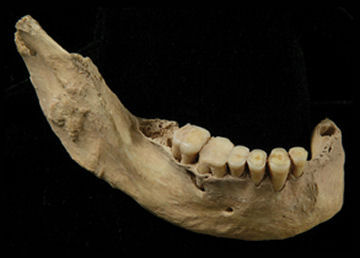A Long Trek to Asia
An ancient skeleton from a Chinese cave shows how far humans walked when they left Africa.
Share this:
- Share via email (Opens in new window) Email
- Click to share on Facebook (Opens in new window) Facebook
- Click to share on X (Opens in new window) X
- Click to share on Pinterest (Opens in new window) Pinterest
- Click to share on Reddit (Opens in new window) Reddit
- Share to Google Classroom (Opens in new window) Google Classroom
- Click to print (Opens in new window) Print
Today, a plane trip from eastern Africa to China takes less than a day. Tens of thousands of years ago, it would have taken a lot longer to walk those 5,000 miles. But now it seems that even without roads, ancient people managed to make that long trip.
Our human ancestors came from eastern Africa. They started leaving that area around 60,000 years ago. Until recently, scientists weren’t sure when these roving humans first arrived in the area now known as China. Only one human skull that was more than 39,000 years old had ever been found in that part of the world.
 |
|
This jawbone came from a 40,000-year-old human skeleton found in China. The find means that humans may have been traveling from Africa to eastern Asia much earlier than scientists once thought. |
| Hong Shang, et al. |
But in 2001, local workers discovered some ancient human bones in a Chinese cave near Beijing. Paleontologists later excavated the site. Studies showed that the bones were 40,000 years old, leading the scientists conclude that people had made the long trek from Africa to China by that time.
The presence of those bones could also mean that humans and now-vanished humanlike species were interbreeding at that time. The scientists who’ve studied the Chinese skeleton say that it has features of both humans and humanlike Neandertals, which lived from 130,000 to 30,000 years ago in Europe and western Asia. The skeleton’s jaw, leg, and arm bones look like those of people today, but the teeth and hand bones are more like those of Neandertals, they say.
The idea of such interbreeding is controversial. Some scientists aren’t convinced. There just aren’t enough fossils from modern humans at that time to say for sure.
Although it was a very long walk from east Africa to China, the ancient people who made the trip may at least have had sturdy shoes. The skeleton has strong legs but delicate toes, and that means the ancient human probably wore some type of shoes—the oldest evidence of footwear ever found.—C. Gramling
Going Deeper:
Bower, Bruce. 2007. Asian trek: Fossil puts ancient humans in Far East. Science News 171(April 7):211. Available at http://www.sciencenews.org/articles/20070407/fob1.asp .
Sohn, Emily. 2006. Stone Age sole survivors. Science News for Kids (Jan. 11). Available at http://sciencenewsforkids.org/articles/20060111/Note2.asp .






